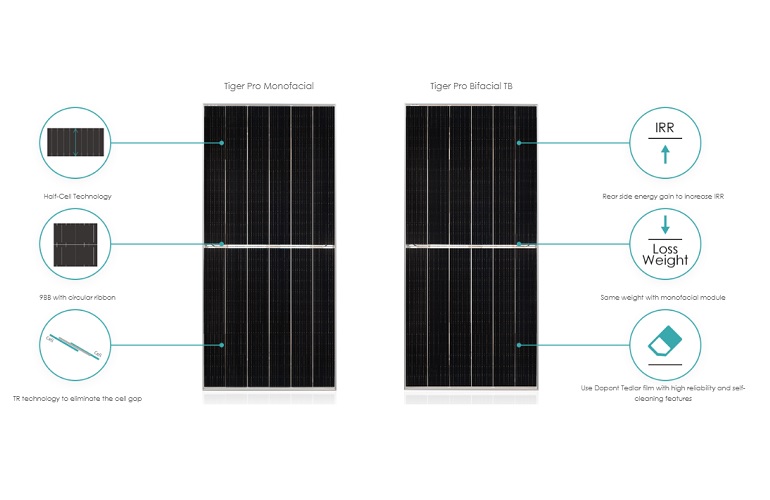JinkoSolar has announced the official launch of its 2020 flagship Tiger Pro module series. Unveiled through a virtual product lunch, the Tiger Pro module series can generate a maximum power output of up to 580 W — 40% higher than current mainstream 72-cell modules.
The Tiger Pro modules use half-cut cells, nine busbars and tiling/shingling ribbon technology to improve performance. Efficiencies have been recorded at 21.6%. The Tiger Pro line features both mono- and bifacial modules. Mass production should commence in Q3.
“The global PV market is rapidly moving toward high-performance modules to reduce system costs and initial upfront capital investment, so it was time to consolidate our competitiveness by leveraging our ability to rapidly begin mass producing cutting-edge products,” said Mr. Kangping Chen, JinkoSolar’s CEO. “We always modify our designs based on customer feedback and market response because designing high-efficiency products in the lab is one thing, but ramping up to mass production drives the entire industry forward together towards grid parity. With various types of modules, Tiger Pro series enables the construction of more powerful and efficient solar power farms that will bring higher return on investment for projects with larger technical and efficiency requirements.”
News item from JinkoSolar





I am a high user with limited space. My residence is over 100yrs old an 10k sq ft. It is restricted by zoning to what i can put over the roof. So it is pretty much limited to the garage or approximately 60 panels. This will meet about a third of the demand in the heat of summer. What is the most efficient panel for residential use? Should I wait for this? Suggested contractors?
I was think of buying the equipment separately.
Canadian Solar is also launching in Jan 2021 590watt, Longi in October 2020 540 watts. Now the race is on.
THIS IS A MAJOR BREAKTHROUGH IN SOLAR RESEARCH.
I have been trying to find out the dimensions of this module for more than 15 days. But couldn’t find still.
The parent Tiger module line is 2182×1029×40mm (85.91×40.51×1.57 inch), with Jinko’s traditional 72-cell Swan module being 2031×1008×30mm (79.96×39.69×1.18 inch). So the Tiger modules are much longer than traditional 72-cell modules. My guess is that the Tiger Pro line would be similarly as large.
300 watts, 600 watts doesn’t mean much if the surface is simply doubled. Increase efficiency from 20% to 40% and now you’re talking. Otherwise all you save is installation costs and maybe a little bit on the panels.
Great product. I trust the reduction in space & weight per Wp could make it viable to put on even high rise and small roofs besides the advantages for large plants. Regards
The renewable energy product cost in the caribbean is very costly. I think these larger mono solar panels will reduce overall cost the the consumers.
It’s interesting what the R&D of the past 10 years has done for solar PV. Well known degradation some call LIDs has been tackled by chemistry and process changes to make panels more robust with less overall degradation. Incremental improvements in panel harvest efficiency has inched up to the “common” crystalline silicon panel having efficiencies from 21% to 24%, in the near future, it looks like enough R&D is going towards tandem solar PV cells and 30% plus efficiency. At 24% solar PV efficiency, a home system is 4% (more) efficient than the grid feed to the house when one looks at generated power and end to end losses through transformer steps.
The tired argument of “the sun doesn’t shine at night” is quickly becoming rote idiocy. Electric utilities in their “wisdom” bring forth “programs” like tiered block electric rates, electricity spiking by calling a TOU period every day and pushing State PUC, SCC agencies for net billing instead of net metering. All the while, solar PV manufactured product is coming in cheaper per watt and more efficient than the intrinsic grid is now. The smart ESS is becoming the go to technology for energy storage. Top of the line ESS are not cheap, something like $28K installed, but, in one package you get batteries, inverter/charger, BMS, HMI, algorithms for energy storage and use control and communications to smart home appliances. Right now solar PV panels are the (least) expensive thing in the system as a whole. Although costly, the solar PV with smart ESS is making sense as a packaged unit, with the ability to control the ESS inverter/charger for the best use of one’s daily solar generation.
Wow! 580 watts is so promising for an avid solar power enthusiast like me. This would really help more people to use renewable energy when it comes out to the market.
A lot of these “new” panels are designed for commercial or utility scale solar PV farms. Typically these panels are 8 foot by 4 foot or 32 square feet for that 580 watts. Right now “typical” residential roofing solar PV panels are 17 to 18 square feet per panel. Let’s look at a roof with say 400 square feet of space for solar PV. For the 580 watt panels, you could install 12 at 6.96kWp, with the 18 square foot panels at an average output of 330 watts, 7.26kWp. There are some newer production panels claiming 360 watts per panel, so, 7.92kWp. When the retail consumer can find tandem solar PV panels in the 30% to 35% efficiency output, this will be the day to buy into solar PV plus energy storage and use the utility as a backup power source. It’s coming and for the last five years, I keep hearing it will be within five years.